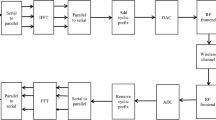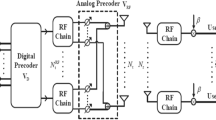Abstract
One of the challenges in massive-MIMO system is pilot contamination during the channel estimation process. Pilot contamination can cause error or inaccurate channel estimation process for future fifth generation (5G) downlink transmissions. This paper considers using a Wiener-based filter to smooth and predict the channel estimation to reduce the pilot contamination for more accurate CSI during channel estimation. The simulation results show that the Wiener-based smoothing and predicting technique reduces the effect of pilot contamination and increases the accuracy of CSI during channel estimation process. Wiener smoother (WS) is implemented based on Wiener-based filtering technique. The previous estimated CSI and weight coefficient vector are used to smooth the current estimated CSI by using block data formulation to reduce the effect of pilot contamination. However, WS technique suffers from pilot contamination due to pilot training. This motivates the development of two Wiener predictors (WP), known as WP1 and WP2. The WP1 and WP2 run a prediction technique for CSI and number of pilot training during the prediction period, which is missing from the original WS. Comparison results show that the proposed WS and WP outperforms the conventional minimum mean square error and least square, in terms of channel estimation error and per-cell rate. WP2 perform better than WS and WP1 because of the algorithm complexity that required more information to be updated, stored and processed for prediction. Thus, WP2 requires large computation and matrix operation compared to WS and WP1. The results indicate that the channel estimation error due to pilot contamination can be reduced by using the Wiener-based approaches.










Similar content being viewed by others
References
Marzetta, T. L. (2010). Noncooperative cellular wireless with unlimited numbers of base station antennas. IEEE Transaction on Wireless Communication, 9(11), 3590–3600.
Astely, D., Dahlman, E., Fodor, G., Parkvall, S., & Sachs, J. (2013). LTE release 12 and beyond. IEEE Communications Magazines, 51(7), 154–160.
Hoydis, J., Brink, S. T., & Debbah, M. (2013). Massive MIMO in the UL/DL of cellular networks: How many antennas do we need? IEEE Journal on Selected Areas in Communications, 31(2), 160–171.
Rusek, F., Persson, D., Lau, B. K., Larsson, E. G., Marzetta, T. L., Edfors, O., et al. (2013). Scaling up MIMO: Opportunities and challenges with very large arrays. IEEE Signal Processing Magazine, 30(1), 40–60.
Yin, H., Gesbert, D., Filippou, M., Liu, Y., et al. (2013). A coordinated approach to channel estimation in large scale multiple antenna systems. IEEE Journals and Magazines, 31(2), 264–273.
Liu, B., Cheng, Y., & Yuan, X. J. (2015). Pilot contamination elimination precoding in multi-cell massive MIMO systems. In IEEE 26th Annual International Symposium on Personal, Indoor, and Mobile Radio Communications (PIMRC).
Bahrani, Z., & Eslami, M. (2014). Least square channel estimation for large-MIMO multi-cell downlink with reduced number of pilots. In 22nd Iranian Conference of Electrical Engineering (ICEE) (pp. 1600–1604).
Ngo, H. O., Matthaiou, M., & Larsson, E. G. (2014). Massive MIMO with optimal power and training duration allocation. IEEE Wireless Communications Letters, 3(6), 605–608.
Nueman, D., Grundinger, A., Joham, M., & Utschick, W. (2014). On the amount of training in coordinated massive MIMO systems. In IEEE 8th Sensor Array and Multichannel Signal Processing (SAM) (pp. 293–296).
Fodor, G., Marco, P. D., Telek, M. (2014). Performance analysis of block and comb type channel estimation for massive MIMO systems. In 1st International Conference on 5G Ubiquitous Connectivity (5GU) (pp. 62–69).
Mazlan, M.H., Behjari, M., Nordin, R., Ismail, M. (2015). Investigation of pilot training effect in massive-MIMO TDD system. In IEEE 12th Malaysia International Conference on Communications (MICC), November 2015.
Appaiah, K., Ashikhmin, A., & Marzetta, T. L. (2010). Pilot contamination reduction in multi-user TDD systems. In IEEE International Conference Communication, May 2010 (p. 15).
Shojafar, M., Abolfazli, S., Mostafaei, H., & Singha, M. (2015). Improving channel assignment in multi-radio wireless mesh networks with learning automata. Wireless Personal Communications, 82(1), 61–80.
Nie, L., Jiang, D., Guo, L., Yu, S., & Song, H. (2016). Traffic matrix prediction and estimation based on deep learning for data center networks. In IEEE Globecom Workshops.
Elijah, O., Leow, C. Y., Rahman, T. A., Nunoo, S., & Iliya, S. Z. (2015). A comprehensive survey of pilot contamination in massive MIMO—5G system. IEEE Communications Surveys & Tutorials, 18, 905–923.
Ashikmin, A., & Marzetta, T. L. (2012). Pilot contamination and precoding in multi-cell lare scale antenna systems. In IEEE International Symposium Information Theory, March 2012 (pp. 1142–1146).
Fernandes, F., Ashikmin, A., & Marzetta, T. (2012). Interference reduction on cellular networks with large antenna arrays. In IEEE International Conference Communications (pp. 5773–5777).
Gopalakrishnan, B., & Jindal, N. (2011). An analysis of pilot contamination on multi-user MIMO cellular systems with many antennas. In International Workshop Signal Processing Advanced Wireless Comunication, June 2011 (pp. 381–385).
Jose, J., Ashikmin, A., Marzetta, T. L., & Vishwanath, S. (2011). Pilot contamination and precoding in multi-cell TDD systems. IEEE Transportation Wireless Communication, 10(8), 2640–2651.
Ngo, H. Q., Marzetta, T. L., & Larsson, E. G. (2011) Analysis of the pilot contamination effect in very large multicell multiuser MIMO systems for physical channel models. In IEE International Conference Acoustics Speech Signal Processing, May 2011 (pp. 3464–3467).
Lee, J., Kim, Y., Kwak, Y., Zhang, J., Papasakellariou, A., Novlan, T., et al. (2016). LTE-advanced in 3GPP Rel-13/14: an evolution toward 5G. IEEE Communications Magazine, 54(3), 36–42.
3GPP TR 36.814. (2016). Evolved universal terrestrial radio access (E-UTRA): further advancements for E-UTRA physical layer aspects. Retrieved March, 2016 from http://www.3gpp.org/ftp/Specs/archieve/36series/36.814/36814-900.zip.
Krishnan, N., Yates, R. D., & Mandayam, N. B. (2012). Cellular systems with many antennas: large system analysis under pilot contamination. In 50th Annual on Conference on Communication (Allerton) (pp. 1220–1224).
Gopalakrishnan, B., & Jidal, N. (2011). An analysis of pilot contamination on multi-user MIMO cellular systems with many antennas. In IEEE 12th International Workshop on Signal Processing Advances in Wireless Communications (pp. 381–385).
Wiener, N. (1949). The linear predictor and filter for multiple time series. Cambridge: MIT Press eBook Chapters.
Wiener, N. (1949). Extrapolation, interpolation, and smoothing of stationary time series: With engineering applications. Cambridge: MIT Press eBook Chapters.
Hagiwara, J., Nishimura, T., Ohgane, T., & Ogawat, Y. (2015). Comparison of Kalman smoother to wiener smoother in practical OFDM channel estimation. In 21st Asia-Pacific Conference on Communications (APCC).
Truong, K. T., & Heath, R. W. (2013). Effects of channel aging in massive MIMO systems. Journal of Communications and Networks, 15(4), 338–351.
Hentilä, L., Kyösti, P., Käske, M., Narandzic, M., & Alatossava, M. (2007). MATLAB implementation of the WINNER Phase II Channel Model ver1.1 (Online). Retrieved March, 2016 from https://www.ist-winner.org/phase_2_model.html.
Mi, D., Dianati, M., Zhang, L., Muhaidat, S., & Tafazolli, R. (2017). Massive MIMO performance with imperfect channel reciprocity and channel estimation error. IEEE Transactions on Communications, PP(99), 1. doi:10.1109/TCOMM.2017.2676088.
Tebe, P. I., Kuang, Y., Opare, K. A., & Kponyo, J. J. (2015). The effect of channel estimation errors on the energy efficiency of downlink massive MIMO systems. In Seventh International Conference on Ubiquitous and Future Networks (ICUFN).
Wang, J., & Wang, J. (2010). Effect of channel estimation error on MIMO–OFDM systems capacity. In 6th International Conference on Wireless Communications Networking and Mobile Computing (WiCOM).
Malik, D., & Batra, D. (2012). Comparison of various detection algorithms in a MIMO wireless communication receiver. International Journal of Electronics and Computer Science Engineering (IJECSE), 1(3), 1678–1685.
Zaib, A., Masood, M., Ali, A., Xu, W., & Al-Naffouri, T. Y. (2016). Distributed channel estimation and pilot contamination analysis for massive MIMO–OFDM systems. IEEE Transactions on Communications, 64(11), 4607–4621.
Acknowledgements
This research has received funding from Ministry of Higher Education, under Grant Ref: FRGS/1/2015/ICT04/UKM/02/2 and Ministry of Sciences, Technology and Innovation (MOSTI), Malaysia under the e-Science Fund 01-01-02-SF1297.
Author information
Authors and Affiliations
Corresponding author
Rights and permissions
About this article
Cite this article
Mazlan, M.H., Behjati, M., Nordin, R. et al. Wiener-based smoother and predictor for massive-MIMO downlink system under pilot contamination. Telecommun Syst 67, 387–399 (2018). https://doi.org/10.1007/s11235-017-0341-0
Published:
Issue Date:
DOI: https://doi.org/10.1007/s11235-017-0341-0




